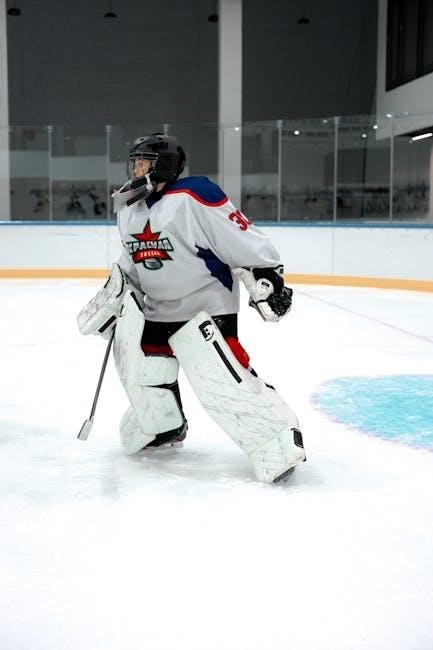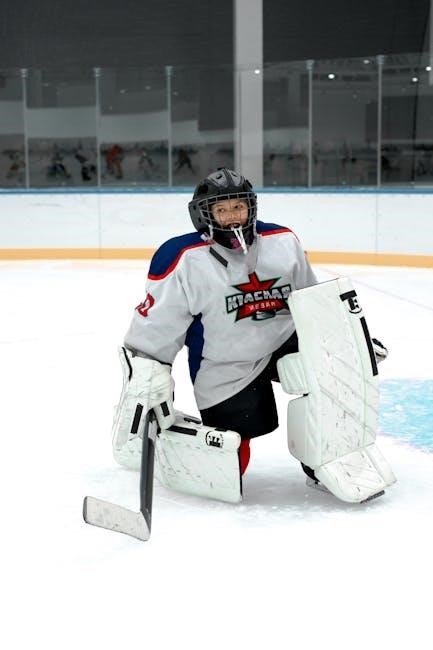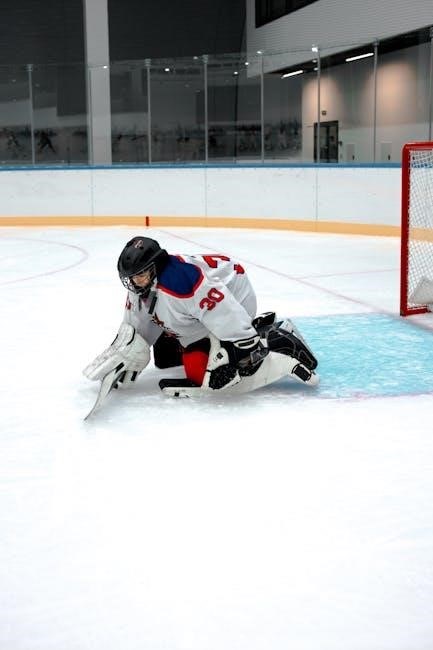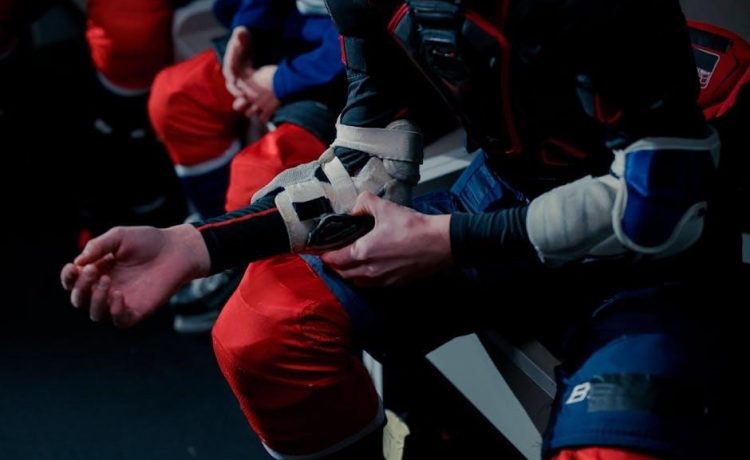Shin Pad Size Guide for Hockey

Hockey shin pads are essential protective gear, with sizes varying by age and leg length. Youth sizes range from 10-12 inches, junior 13-15 inches, and senior 14-16 inches. Proper fit ensures mobility and protection.

Hockey shin pads are essential protective gear designed to safeguard the lower leg, knee, and shin from impacts during the game. Made from durable materials like plastic, foam, and fabric, they provide critical defense against sticks, pucks, and collisions. Shin pads are worn under hockey socks and are a mandatory piece of equipment for players of all ages and skill levels. Properly fitted shin pads ensure mobility, comfort, and optimal protection, making them a cornerstone of hockey safety. Their design varies slightly between youth, junior, and senior players, accommodating different leg lengths and growth stages. Understanding the importance of shin pads and how to choose the right size is crucial for both performance and injury prevention. This guide will walk you through sizing, measurement techniques, and selection tips to help you find the perfect pair for your needs.
Why Proper Shin Pad Sizing Matters
Proper shin pad sizing is crucial for both protection and performance in hockey. Ill-fitting shin pads can leave areas of the leg exposed, increasing the risk of injury from impacts. Conversely, pads that are too large can restrict movement and cause discomfort, affecting a player’s ability to skate or maneuver effectively. Correct sizing ensures that the pad covers the shin, knee, and lower leg adequately, providing maximum protection without hindering mobility. Additionally, proper fit prevents the shin pad from shifting during play, maintaining consistent defense against collisions and falls. Improperly sized shin pads can also lead to discomfort, fatigue, and decreased focus during games. Therefore, taking the time to measure and select the right size is essential for safety, confidence, and overall performance on the ice. Proper sizing directly impacts a player’s ability to play effectively and safely, making it a priority when selecting hockey gear.

How to Measure for Hockey Shin Pads
Measure from the center of the knee cap to the top of the skate boot. This length determines the shin pad size, ensuring proper coverage and protection during play.

Measuring Techniques for Accurate Fit
To ensure an accurate fit, measure from the center of your knee cap to the top of your skate boot. This length determines the appropriate shin pad size. For youth players, sizes typically range from 10 to 12 inches, while junior and senior players require larger sizes. Proper measurement ensures the pad stays in place, providing optimal protection without restricting movement. Additionally, consider how you wear your shin guards—over or under the skate tongue—as this can affect sizing. Always refer to the manufacturer’s size chart for specific guidelines, as some brands may vary. Trying them on before purchase is highly recommended to confirm comfort and fit.
Factors Influencing Shin Pad Size
Several factors influence the appropriate size of hockey shin pads. Player height and leg length are primary considerations, as they determine the necessary coverage. Youth players typically require smaller sizes, while taller athletes need longer pads. The style of play also matters; for example, defenseman may prefer longer pads for added protection. Skate size and boot height can affect how the shin pad fits, ensuring it doesn’t interfere with movement. Personal preference plays a role too, as some players prioritize comfort over maximum protection. Additionally, the position—forward, defense, or goalie—can influence size, with goalies often needing specialized gear; It’s crucial to balance protection with mobility, as ill-fitting pads can hinder performance. Always consult size charts and consider these factors to select the right shin pads for optimal protection and comfort during the game.
Hockey Shin Pad Size Charts
Size charts categorize shin pads by age and leg length, with youth (10-12″), junior (13-15″), and senior (14-16″) options. Proper fit ensures protection and mobility for all players.
Youth Shin Pad Sizes
Youth shin pads are designed for younger players, typically aged 5-12 years. Sizes range from 8 to 12 inches, corresponding to player heights of 4′ to 4’10”. Proper fit is crucial for protection and mobility. Measure from the top of the skate boot to just below the kneecap. Ensure pads cover the shin and knee without restricting movement. Youth sizes are smaller and lighter to accommodate growing legs. Choosing the right size prevents injuries and enhances comfort during play. Parents should consider their child’s growth rate when selecting a size, as shin pads that are too large may shift during games. Refer to the size chart for precise measurements, ensuring optimal fit for young athletes. Proper sizing ensures safety and performance, making it essential for youth players to wear correctly fitted shin pads.
Junior Shin Pad Sizes
Junior shin pads cater to players aged 13-15, with sizes ranging from 13 to 15 inches. These pads are designed for growing athletes, offering a balance between protection and mobility. Measure from the top of the skate boot to just below the kneecap to determine the correct size. Players between 4’6″ and 5’2″ typically fit junior sizes. The pads should cover the shin and knee without being too bulky. Proper fit ensures optimal protection during gameplay. Junior shin pads are slightly larger than youth sizes but smaller than senior models, accommodating the intermediate growth phase. It’s important to try them on with skates to ensure a snug fit, as ill-fitting pads can lead to discomfort or inadequate protection. Refer to the size chart for precise measurements, ensuring the pads align with the player’s height and leg length for maximum safety and performance.

Senior Shin Pad Sizes
Senior shin pads are designed for adult players and typically range from 14 to 16 inches in length. These pads are constructed for taller athletes, usually those over 5’4″, and provide maximum protection for high-impact gameplay. The sizing corresponds to the player’s height, with 14-inch pads suiting players between 5’4″ and 5’7″, 15-inch pads for those between 5’7″ and 5’10”, and 16-inch pads for players taller than 5’10”. Proper fit is crucial, as senior shin pads must cover the entire shin and knee without restricting movement. Measure from the top of the skate boot to just below the kneecap to determine the correct size. Senior pads are larger and more protective than junior or youth sizes, ensuring durability and comfort for advanced players. Always try them on with hockey skates to ensure a snug, secure fit, as improper sizing can lead to discomfort or reduced protection during games.

Choosing the Right Shin Pad
Selecting the right shin pad involves considering factors like size, material, and personal comfort. Proper fit ensures optimal protection and mobility during gameplay, enhancing overall performance on the ice.
Considerations for Shin Pad Materials
When selecting shin pads, the material plays a crucial role in both protection and comfort. High-density foam is commonly used for its ability to absorb impact effectively. Lightweight plastics and carbon fiber are also popular, offering durability while maintaining flexibility. Moisture-wicking fabrics are essential for keeping legs dry during intense games; Some shin pads feature removable liners for easy cleaning, which helps prevent bacterial growth. Additionally, considering the thickness of the padding can impact mobility; thinner pads allow for better movement, while thicker ones provide extra protection. It’s important to balance these factors based on your playing style, position, and personal preference. Proper fit and material choice ensure that shin pads perform optimally, protecting without restricting movement. Always look for materials that align with your needs for comfort and protection.
Importance of Trying Them On

Trying on shin pads is essential to ensure a proper fit, as sizing charts may not always account for individual leg shapes and preferences. A correct fit prevents restricted movement and provides optimal protection. Shin pads that are too tight can hinder circulation and comfort, while those that are too loose may leave areas vulnerable to impact. When trying them on, wear them over your hockey socks or skate tongue, depending on your preference, and ensure they stay securely in place. Check that the pads cover from just below the knee to the top of the skate boot. Pay attention to how they feel during movement, as a proper fit should allow for a full range of motion without shifting. Personal preference plays a significant role, so testing different styles and brands can help find the best match for your comfort and performance needs.

Properly fitted shin pads are crucial for safety and performance. Always measure carefully, try them on, and consider personal comfort. Prioritize quality materials for optimal protection and durability in hockey.
Key Takeaways for Optimal Fit

Ensuring your shin pads fit correctly is vital for both protection and performance. Start by measuring your leg from the top of the skate boot to just below the knee cap. This length will guide your size selection. Youth sizes typically range from 10 to 12 inches, while junior and senior sizes extend up to 16 inches. Remember, proper fit means the pads should stay in place without restricting movement. Try them on with your skates to confirm comfort and coverage. Additionally, consider the thickness of the padding and whether it suits your playing style. Quality materials and a secure fit will enhance your overall hockey experience, reducing the risk of injury and improving your game.
Additional Resources for Hockey Equipment
For further guidance on hockey shin pads and equipment, explore reputable resources like official manufacturer websites, such as Bauer or CCM, which offer detailed sizing charts and product guides. Online retailers like HockeyMonkey and Pure Hockey provide comprehensive buying guides and customer reviews to aid your selection. Additionally, instructional videos on platforms like YouTube can demonstrate proper fitting techniques and product comparisons. Many hockey communities and forums, such as Reddit’s r/hockeygear, share firsthand experiences and recommendations. Local hockey shops often employ knowledgeable staff who can assist with fittings and advice. Staying informed through these resources ensures you make the best choice for your needs, budget, and playing style. Always prioritize quality and fit to enhance performance and safety on the ice.
